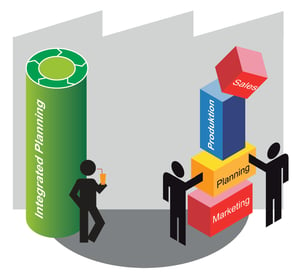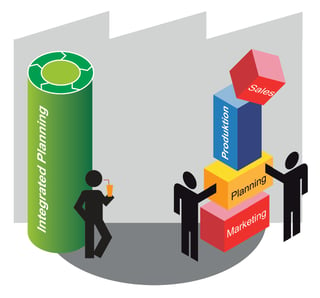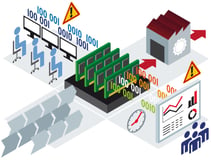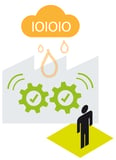Why Integrated Planning Means A Better Business Model
Nick Ostdick - February 15, 2018

 We discuss in great detail on this blog how integrated processes and optimized models result in enhanced operations, increased productivity, and more effective strategic vision. While these are certainly critical and worthy elements of discussion, they are part and parcel to a much larger concern we devote little conversation to: How these various planning and production techniques actually result in a more innovative way of doing business. Because, at the end of the day, a manufacturing company is a business, and a software solution or platform is only as valuable insofar as it helps a business develop and grow.
We discuss in great detail on this blog how integrated processes and optimized models result in enhanced operations, increased productivity, and more effective strategic vision. While these are certainly critical and worthy elements of discussion, they are part and parcel to a much larger concern we devote little conversation to: How these various planning and production techniques actually result in a more innovative way of doing business. Because, at the end of the day, a manufacturing company is a business, and a software solution or platform is only as valuable insofar as it helps a business develop and grow.
For example, take the idea of integrated production planning. Such a planning method is a core driver in helping today’s manufacturing companies (especially those in variant-rich industries such as automotive or packaging) not only reduce costs, but also create inroads for revenue generation and growth across the value stream.
By moving away from error-prone planning platforms like Excel spreadsheets and other manual data input and management methods, manufacturing companies can then leverage more effective planning and production programs, which in turn makes it easier to allocate resources for more accurate transport solutions. Optimized solutions and integrated planning software offer companies the ability to reduce the likelihood of supply chain bottlenecks and increase inventory flexibility through trend analysis, past demand reporting, forecasting, and simulation capabilities.
But what does all this mean in terms of creating an effective, profitable business model? How do these enhanced planning elements work to make a manufacturing company more nimble and agile in a globally-competitive sphere? These are the questions to ask when considering how integrated planning means a better business model for modern manufacturing companies.
Trend analytics and pattern recognition
Analytics and reviews of efficiency are key for companies in leveraging the benefits of integrated planning. Isolating spikes and dips in warehouse holdings, transportation volumes, and container inventory are key to implementing a planning strategy for the upcoming year, and intelligent planning software allows planners to conduct in-depth reviews and generate simple, integrated reporting to increase supply chain transparency and reduce overall costs.
But trend analysis capabilities can extend beyond the confines of traditional supply chain logistics to include a number of external factors that impact the supply stream. These analytics can offer manufacturers and suppliers great insight into industry-wide buying trends, which will help streamline all points of the supply stream. A report last year from Reuters indicated the current global decline in gasoline and oil prices sparked a significant increase in automotive sales last December throughout much of North America, and many economists believe this strong uptick in sales will continue throughout much of 2016. The ability to monitor this trend and produce predictive models on future fluctuations in the demand for trucks and other industrial vehicles can be crucial to manufacturers and suppliers ensuring enough product to successfully and promptly fill orders and ensure on-time delivery.
Emphasis on previous demand levels
Because modern manufacturing takes place on a global stage with a vast array of network partners and major players, companies have to cut through more complexity to achieve enhanced visibility and agility. As such, the margin for error relative to late deliveries and errors in product quantity is becoming slimmer and slimmer. Repeat instances of either can result in severe losses in productivity, revenue, and growth. The ability to reference past demand for products is essential in ensuring these products ship and are delivered on-time and in the correct quantities. Integrated planning software also helps increase the visibility and transparency for past demand across an entire company, allowing for a more collaborative, coordinated effort in creating consistent, synchronized planning. The more individuals with access to a company’s past demand data, the more capable that company will be in creating accurate and efficient forecasting. A better understanding of what you’ve been gives planners and managers a more accurate picture of where you’re going, which allows companies to unlock business moments and opportunities to leverage production sequences more in-line with customer or market demand.
More accurate forecasting
In such a complex industry, it would stand to reason the ability to forecast future planning and production programs based on analytics, prior customer demand, and potential market forces would be a critical function for planners and managers in an integrated planning platform and to help reduce transport costs. Forecasting capabilities via intelligent planning software can also be useful in establishing sales and supply chain benchmarks to help promote and encourage a company’s organic growth. Establishing such benchmarks and creating an accurate prediction of supply and sales over an upcoming span of time better equips a company to determine how and where to best allocate sales, shipping, container and warehouse resources to eliminate waste and increase communication across a variety of positions. The ability to run simultaneous simulations for a variety of potential supply chain bottlenecks is a value-added proposition for any manufacturing company looking for methods of increasing visibility and transparency across a variety of platforms, while at the same time reducing costs and increasing communication and collaboration in a cross-organizational manner.
LATEST POSTS
- Understand Circular Economy in The Manufacturing Industry
- How Can Industry 4.0 IT Integration Be Achieved Smoothly?
- The Significance of Order Sequencing in Discrete Manufacturing
- How to improve your Supply Chain Management: The Power of Control Towers
- Optimizing Human Resource Scheduling in Manufacturing: A Technological Approach



